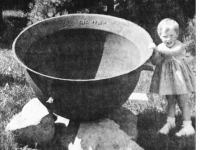
The arc of history can often be seen only at great temporal remove. Only then is the importance of certain practices revealed. Likewise, some undertakings are so prevalent and quotidian that their mention seems almost unnecessary. Thus, it seems, was nascent potash production. Everyone saved ash from the woodstove; it’s how you made soap. Doing so was as unremarkable as feeding the horses or collecting the eggs. Like eggs, you could sell excess ash. Perhaps the sheer normalcy of ash collection is why it has been given scant attention in the histories of Lower Canada. But whether left unmentioned due to ignorance or to misunderstanding, the sale of potash contributed significantly to the prosperity of the Eastern Townships in the first half of the 19th century.
“[A] man’s profits are never greater than at the time of clearing his lands,” wrote Judge William Cooper, founder of Cooperstown, New York[1]. The pioneers of Eastern Townships knew that. They actively cut down trees, and burned the trunks, branches and stumps to produce potash, which sold at good profit. The demand for potash, and the price paid for it, became quite high when that demand later included industrial operations.
To read the rest of the article, click here!